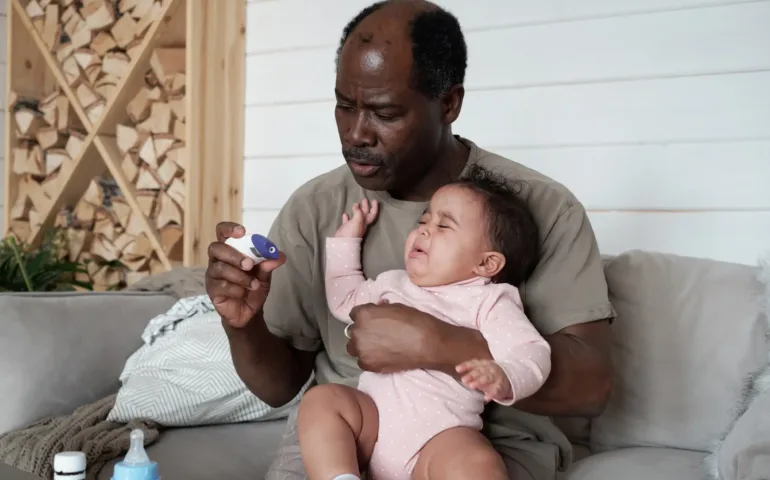
The basics of infant sleep
Here’s what you need to know about your baby’s sleep patterns.Baby’s sleep rhythms
At birth, your baby’s sleep is very different from that of an adult. It is characterized by:- Very short cycles: a newborn alternates between sleep cycles of around 40 to 50 minutes, compared to 90 to 120 minutes in adults. At the end of each cycle, they may briefly wake up, then fall back asleep or need your presence to feel soothed.
- Active or REM sleep: this is the dominant phase, accounting for about 80% of your baby’s sleep time. During this phase, they move, may breathe irregularly, and sometimes even open their eyes… but they’re sleeping!
- Quiet sleep: your baby’s body is relaxed, their breathing is regular, and their face is calm. This is when their body recovers physically.
Common sleep disturbances
In the first months, your baby’s sleep is not yet regulated, and it’s perfectly normal to face difficulties falling asleep or nighttime awakenings.- Frequent awakenings: your infant often wakes between cycles, mainly due to hunger or temporary discomfort.
- Crying at bedtime: crying is a normal form of expression for your baby. They’re signaling that they need something or simply asking for a cuddle or your presence to feel reassured.
- On-demand breastfeeding: breastfed babies often seek the breast to fall asleep or to go back to sleep during nighttime awakenings.
Discharge and sleep-onset crying
Discharge crying refers to frequent episodes where your child releases the tensions accumulated throughout the day. These episodes usually occur in the evening and are not health-related but rather a natural mechanism for managing stress and emotions.Several factors can trigger this crying: fatigue, overstimulation, stress from new situations, or frustration linked to their limited autonomy. Manifestations can include intense crying, angry gestures, or rejection behaviors.To support your child, it is recommended to stay calm, establish a soothing routine, reduce stimulation, and welcome their emotions with empathy.Crying at bedtime is also very common and allows your baby to release tensions so they can let go and fall asleep. Just like we sometimes need to “process” thoughts for a few minutes before sleeping, your baby may need to “grumble” a bit before drifting off.However, if the crying becomes excessive, comes with behavior changes, or persists despite your efforts, it’s advisable to consult your healthcare professional to rule out any underlying issues.
Want to learn more? Feel free to download the May app, where you’ll find plenty of resources to support and guide you throughout your pregnancy.

Letting your baby cry to sleep: a solution?
Crying at sleep onset is therefore completely normal and often a way for your child to find sleep. Should you let them cry without intervening?The intensity and duration of crying
As we’ve seen, crying at sleep onset can be a way for your child to find sleep.As long as the crying is mild and short, you can leave your baby for a few minutes to fall asleep in their crib without intervening. But if the crying lasts longer or is more intense, it may mean that your baby needs your presence to meet one of their needs or to feel reassured. Far from you, your baby may feel a significant sense of insecurity.Your presence is soothing for your infant. It is therefore recommended to respond to your child’s cries, especially in the first months.Why is proximity so important?- A baby who feels heard and comforted learns that they can rely on their parents to calm their fears or discomforts.
- Room-sharing, also known as co-sleeping, is recommended by the WHO up to 6 months. It facilitates on-demand breastfeeding, makes it easier to detect signs of wakefulness, and allows quick responses to your baby’s needs, reducing the duration and intensity of nighttime crying.
- Hold them in your arms or gently rock them if they’re crying.
- Speak calmly, place a hand on their tummy, or offer a cuddle.
The 5-10-15 method: a bad idea
You may hear about the Ferber method, often called the “5-10-15 method.” This approach involves gradually spacing out your interventions when your baby cries at bedtime or during nighttime awakenings.Be careful, this method, popularized in the 1980s, does not actually offer educational benefits. In reality, your infant cries to express a need, whether emotional or physiological. When left to cry without intervention, they’re left alone facing intense stress. Repeatedly, this stress can also potentially impact their brain development.The effects are far from positive. On the contrary, they mainly learn to stop expressing their needs, adapting to the absence of response from their caregivers. Gradually, they may withdraw into themselves. This adaptive behavior is not a sign of autonomy, but rather a survival mechanism.
Alternatives to soothe and help your baby fall asleep
Here are some tips to soothe and calm your child at bedtime. Establishing a simple routine with bedtime rituals every night creates a predictable and reassuring environment for your child.Examples of soothing routines:- a warm bath followed by a gentle massage to relieve the day’s tensions,
- a long cuddle, a lullaby, or a calmly told story,
- offering their favorite comfort toy,
- dimming the lights and avoiding stimulation like screens,
- putting them to bed at regular times, even for naps, helps structure your baby’s rhythm.
- Pay attention to signs of fatigue like staring into space, rubbing eyes, or yawning to put your baby to bed before they become overtired.
- If one night the routine doesn’t go as planned, there’s no need to worry. What matters most is long-term consistency, not perfection every single time.
** Photo credits: valuavitaly | Johnstocker This text was translated from French by an artificial intelligence. The information, advice, and sources it contains comply with French standards and may therefore not apply to your situation. Make sure to complement this reading by visiting the May ES/UK app and consulting the healthcare professionals who are supporting you.




